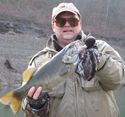By Lee McClellan
Special to NKyTribune
(This is the eighth installment of the “Spring Fishing Fever” series of articles, detailing productive fishing techniques and opportunities across Kentucky. The series will continue until early summer. An archive of past articles is available on the department’s website at www.fw.ky.gov).
May is a special time for anglers who chase redear sunfish and bluegill as they move into the shallows to spawn.
“I think we still might be a week or so from the peak for redear fishing,” said Maj. Shane Carrier, assistant director of law enforcement for the Kentucky Department of Fish and Wildlife Resources. “The old timers say the timing is all about the full moon in May, but this year the full moon isn’t until May 21. I do best the second week and going into the third week of May.”
Carrier fishes a bluegill grub available at tackle shops around Kentucky Lake consisting of short strands of rubber threaded through a 1-inch cigar-shaped plastic grub for redear, but also catches many fish on 1/32-ounce black and yellow feather jigs. He tips both the grub and feather jig with wax worms and suspends them under a slip bobber.

“I use a slip bobber instead of a clip-on,” Carrier said. “You can throw a slip bobber in a pocket in weeds or brush and the bait falls straight down to the fish. If you are using a clip-on bobber, the bait may get hung in the weeds or brush and not get down to the fish. A clip-on bobber still works well in open water situations.”
Kentucky Lake and Lake Barkley are the best lakes in Kentucky and arguably the upper South for redear sunfish. These lakes regularly produce fish longer than 11 inches. The ability of a redear sunfish to use their body shape to pull against a rod produces great sport.
“I’ve caught more redear on these lakes in the back of the bays where the water coming into the lake pushes up gravel bars,” Carrier said. “The redear much prefer the gravel bars in May.”
Redear sunfish spawn a little deeper than bluegill, so anglers usually fish from 2- to 6-feet deep.
Many smaller lakes in Kentucky such as Briggs Lake in Logan County, Elmer Davis Lake in Owen County, Marion County and Fagan Branch lakes in Marion County, Cedar Creek Lake in Lincoln County, Clear Creek Lake in Bath County and McNeely Lake in Jefferson County all hold bountiful populations of redear sunfish.
The soft bottoms on most of these smaller lakes make weedlines the best spots for redear sunfish. Fish weed edges with 1/16-ounce yellow feather jigs tipped with wax worms and suspended under slip bobbers. Many anglers bottom fish redworms beside the weedlines for redear.
Bluegill inhabit practically all water bodies in Kentucky and also spawn in May. Farm ponds, smaller lakes, large reservoirs and rivers all have them. They provide great fun as they readily bite and make the best fish to introduce kids to fishing.
For the best bluegill fishing, probe the outer edges of weedlines with a redworm impaled on a No. 6 Aberdeen hook suspended under a clip-on bobber. Adjust the depth of the bobber until you find fish.
For more outdoors news and information, see Art Lander’s Outdoors on KyForward.
Any sunken tree top, root wad or brush pile should also be worked for bluegill with a redworm suspended under a bobber. Some anglers like to throw 1–inch yellow curly tailed grubs rigged on a 1/32-ounce leadheads or tiny spinner and grub combinations that resemble a Beetle Spin in these same spots for larger bluegill.
Bluegill often nestle in the cracks in rock bluffs on Lake Cumberland, Herrington Lake, Laurel River Lake and other lakes with exposed rock in May. A fly rod angler can find great fishing with small chartreuse, yellow or white poppers fished beside these bluffs. Bluegill will come from a good distance to smack these topwater presentations. A 3-weight fly rod makes a hand-sized bluegill feel like a 5-pound smallmouth bass.
Spinning anglers using ultra-light equipment can also cast poppers by using a clear casting bobber attached to the line roughly 3 feet above the popper. Sponge spiders also work well in this situation for both fly rods and spinning gear.
The redear sunfish and bluegill are shallow and biting. It is time to enjoy some of the fastest fishing action of the year.
Author Lee McClellan is associate editor for Kentucky Afield magazine, the official publication of the Kentucky Department of Fish and Wildlife Resources.
The Kentucky Department of Fish and Wildlife Resources manages, regulates, enforces and promotes responsible use of all fish and wildlife species, their habitats, public wildlife areas and waterways for the benefit of those resources and for public enjoyment. Kentucky Fish and Wildlife is an agency of the Tourism, Arts and Heritage Cabinet. For more information on the department, click here.


















